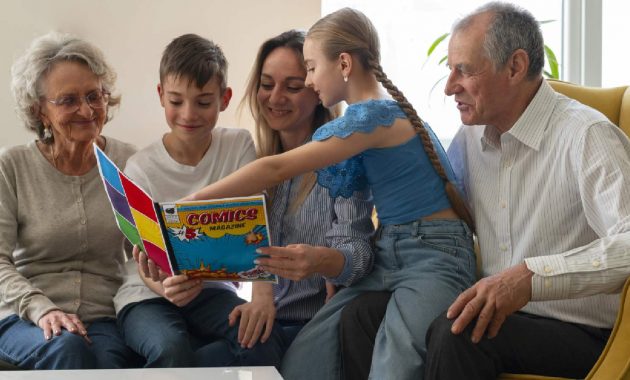Living with your parents and other relatives is good for your mental health. On the occasion of International Day of Families, check out the benefits of living in a joint family.
Thasana Lourembam, a 25-year-old Manipur-based teacher, starts her day by making meals for her family. She is not the only one. She is joined by her mother and aunt. Her cousins are responsible for keeping the house clean. Meanwhile, her brother looks into the needs of their grandparents, and her father and uncle keep her nieces entertained. They share their joys and sorrows, success and failures. Living in a joint family has many advantages – from reducing stress on a single person, building a strong support system and fostering bonding to lowering the risk of loneliness. On the occasion of International Day of Families, observed on May 15 every year, we tell you the benefits of living in a joint family.
What is a joint family?
Living in a joint family is a family arrangement in which multiple generations, such as grandparents, parents, children, and their spouses, live together in the same home. This structure divides resources, duties, and decision-making among family members, says psychotherapist and life coach Dr Chandni Tugnait.

What are the benefits of living in a joint family?
Children from joint family have better mental health compared to those from nuclear family, according to a research published in the BMC Public Health journal in 2021. Also, children with higher family engagement generally may have
fewer psychological complaints and greater life satisfaction compared to those with lower family engagement, as per a 2022 study published in the Journal of Adolescent Health.
While nuclear families are becoming a norm, here are some more benefits of living in a joint family:
1. Built-in support system
With multiple generations living together, there is an easily accessible network of emotional, practical, and financial assistance. This can be especially useful at times of stress, illness, or life transitions like marriage or pregnancy.
Also Read

2. Less stress
Childcare, household chores, and caregiving for senior family members can be distributed among multiple members. This reduces the weight and stress on any single individual.
3. Intergenerational learning
Joint households enable knowledge and skill sharing across generations, says the expert. Children can benefit from their elders’ expertise and experiences, while the older generation can keep up with changing cultural trends through the younger members.
4. Better mental health
Being a part of a close-knit, extended family can provide a strong sense of identification, belonging, and emotional stability. These can help in improving mental health.
5. Conflict resolution skills
Managing the complexities of a combined family necessitates good communication, compromise, and conflict resolution skills. These can lead to improved interpersonal abilities and emotional intelligence.
6. Companionship and social engagement
Having multiple family members living together provides a constant supply of companionship and social engagement. These can be especially good for youngsters and the elderly, lowering the risk of loneliness and social isolation.
Select Topics of your interest and let us customize your feed.
PERSONALISE NOW
7. Emotional resilience
Experiencing other family members’ perspectives and coping techniques can help people build emotional resilience and adaptability. These can help in preparing them to face life’s obstacles.

What are the disadvantages of living in a joint family?
Living in a joint family has many advantages, but you should also recognise the potential drawbacks and obstacles that may develop.
- Individual privacy and personal space may be jeopardised when numerous families live together, leading to feelings of overpopulation and a lack of autonomy.
- If differences in personality, values, and lifestyles within the extended family are not addressed by open conversation and compromise, they can lead to conflicts, and power struggles.
- Family members may mistakenly or purposely interfere with personal decisions or provide unsolicited advise, causing resentment and tension in relationships.
- Creating appropriate boundaries between family members can be difficult, especially when it comes to decision-making, finances, and parenting methods.
- Supporting a big household can impose a strain on the family’s finances, especially if income sources are limited or there are arguments about resource allocation.
- Balancing different lifestyles, such as dietary choices, religious practices, or personal habits, can be difficult and lead to conflict within the joint family.
How to strengthen bonds in a joint family?
At times, people live in a joint family, but don’t have a great bond. Strengthening relationships in a joint family involves intentional effort, honest communication, and a willingness to tolerate varied opinions, says Dr Tugnait.
- Prioritise quality time together through regular family meetings, eating meals together, or engaging in leisure activities that encourage connection and build cherished memories.
- Clear roles, responsibilities, and boundaries can help prevent conflicts and foster peace in the home.
- Promote open and polite discussion in which each family member’s voice is heard and appreciated.
- Celebrate individual triumphs and milestones together to foster a sense of community and pride.
- Find ways to commemorate and preserve family traditions, such as cultural festivities or storytelling, to deepen intergenerational bonds.
To enjoy the benefits of living in a joint family, you must embrace your household’s unique dynamics and diversity. Build a strong support structure based on love, respect, and a shared commitment to provide a harmonious and rewarding living experience for all the members.
#benefits #living #joint #family
